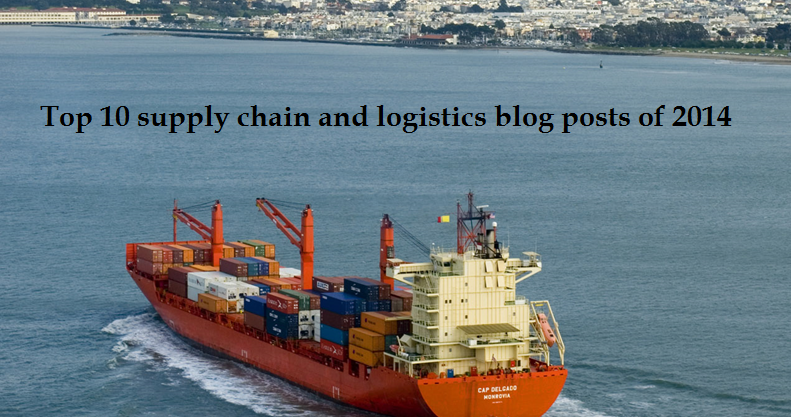
by Fronetics | Jan 5, 2015 | Blog, Content Marketing, Internet of Things, Logistics, Marketing, Social Media, Strategy, Supply Chain, Talent

Here are the top supply chain and logistics blog posts of 2014
2014 is over and a new year has begun. We look back at the content we created and shared in 2014.
Looking at content focused on the supply chain and logistics industries, there are three topics which garnered the most interest:
- The use of social media and content marketing;
- Supply chain talent;
- Technology.
Here are the top ten supply chain and logistics blog posts of 2014 based on pageviews. #1 receiving the most pageviews.
The Internet of Things trend is quickly approaching and will impact the way we live and work through increased productivity and efficiency. Supply Chain Management will continue utilizing these advanced technologies to improve factory workflow, increase material tracking, and optimize distribution to maximize revenues. Read the full blog post.
Within the past five years companies within the logistics and supply chain industries have begun to see social media as a strategic tool and have begun to actively use and leverage social media. A survey conducted by Fronetics Strategic Advisors looks, broadly, at the use of social media within the logistics and supply chain industries. The report discusses use, motivations, preferences, benefits, and challenges. Read the full blog post.
Santa’s supply chain was the first to run “in the cloud.” Read the full blog post and check out the infographic.
Looking at the manufacturing, supply chain, logistics, transportation, distribution and freight industries there are a few companies that have emerged as leaders – companies that exemplify the business value of creating and executing digital, social media, and content marketing strategies. Cerasis, a freight logistics company, is one of these companies. Read the full blog post.
The supply chain industry has a talent crisis. The question is: how can we solve this crisis? To answer this question I turned to Rodney Apple, founder of the SCM Talent Group. Apple has worked as a supply chain recruiter for the majority of his 19+ year career within the staffing industry and he has filled more than 1,000 positions within the industry ranging from executive-level in Fortune 500 headquarters settings to leadership and staff-level roles across large networks of manufacturing and distribution facilities within North America. Apple’s role affords him the ability to witness the talent crisis from the perspective of the industry, the company, and the job seeker. Read the full blog post.
The purpose of this series of blog posts is to give others in our industry and especially those in the manufacturing industry, a guide to create an effective digital, social media, and content marketing strategy which will produce results for your company. If you have followed the Cerasis blog since its launch in March 2013, you have noticed that we work really hard at executing our strategy. The reason we work so hard is because we are passionate about educating the marketplace on information that matters to them. In that way, we want to be the de facto expert in the manufacturing and logistics industries. If we can help those who are our customers and potential customers (manufacturers and distributors) with best practices around logistics and freight, as well as manufacturing industry news, we are continuing our mission of driving long term value (even if we give the information away for free). The result (we hope and have seen) is that people view us as the expert and will want to engage us in a long term relationship as their logistics services provider. We hope this is helpful and you learn something from it! Read the full blog post.
3PL provider Coyote Logistics is one of the fastest growing companies in North America. The company’s incredible growth (five-year growth: 3,585 percent) and tenacious spirit has not gone unnoticed. Forbes included Coyote in its list of Most Promising American Companies; Supply & Demand Chain Executive listed Jeff Silver, Coyote CEO, as one of their “Pros to Know;” and the company was listed as one of the best places to work by the Chicago Tribune. There are undoubtedly many factors that have contributed to the success of the company. Coyote’s approach to social media is likely one of the company’s keys to success. Read the full blog post.
Here’s the thing – the supply chain industry is perceived by those outside the industry as having no “wow” factor whatsoever. If the supply chain industry is going to attract new and qualified talent, it needs a face lift. It is time for the supply chain industry to re-brand itself. Read the full blog post.
Without a comprehensive social media strategy, your message may be getting lost in the chatter. There are a number of tools that will help you monitor your online influence and, effectively, make the necessary adjustments to ensure your efforts are paying off. Here are 10 free tools to help you measure your social media ROI. The basic features of each of these tools are free. Read the full blog post.
Regularly tracking your relationship with your suppliers and their performance toward your expectations is critical to ensure the success of your business. One mechanism for tracking this is the supplier scorecard. A scorecard is in essence a report card for your supplier. Supplier scorecards when used effectively can help maintain a healthy supply chain and will benefit both parties. If not used effectively supplier scorecards can damage the supplier relationship and hurt both businesses. Read the full blog post.

by Fronetics | Jan 1, 2015 | Blog, Content Marketing, Marketing, Strategy, Talent

93% of B2B marketers use content marketing. However, less than half (42%) of B2B marketers say that they are effective at content marketing. One of the reasons these marketers are ineffective: bad content.
All content is not created equal. There is good content. There is bad content. Good content drives profitable customer action. Bad content does not drive profitable customer action.
You need good content.
What is good content? Here are 3 elements of good content:
1. Good content is original
Good content is content that is unique. It is not content that is copied and pasted. It is not regurgitated content. Not only is original content SEO friendly, original content is customer-friendly. 70% of consumers prefer to get to know a company through original articles.
2. Good content stands out
There are more than 27 million pieces of content shared each day. If you want your content to get lost, create bad content. If you want content that stands out you need content that differs from that of the rest of the pack. You can make content stand out by using winning headlines, graphics, images, infographics, and with great writing.
3. Good content attracts and engages current and prospective customers
Every single piece of content that makes it onto your website and blog needs to be content that is created with your current and prospective customers in mind.
Content that attracts and engages is not a sales pitch. Rather, it is content that communicates valuable information to customers and prospects so that they have the knowledge to make better informed decisions. Moreover, it is content that establishes your business as a reliable source of knowledge – as the thought-leader within the industry.
Good content excites customers and prospects and makes them want to reach out to you.
You get what you pay for
Content creation takes time. However, time is often hard to come by. 69% of content marketers feel a lack of time is their greatest challenge. Moreover, almost 50% of marketers struggle with producing enough content, and producing content that engages.
Faced with constraints of time and volume, quality often takes a hit. In some cases the company itself creates and distributes content of poor quality. In other cases, the company chooses to outsource content creation, but does not do their due diligence with respect to the outsource partner and the quality of content that is created.
Good content is not inexpensive. That being said, good content is worth its weight in gold. This is not something I just say, this is something I know. I gave several low cost content options a try.
I began by conducting a search for companies that offered low-cost content (content that costs less than $20 per blog post). I then narrowed the field down even more by researching which of these companies had the highest rankings and customer satisfaction rates. I then selected two companies and decided to give it a go.
The results were dismal. The content was not good content.
If you want content that is good content and will drive profitable results you need to invest. You need to either invest in someone in-house, or you need to conduct your due diligence and find an outsource partner that can create good content for your company.
Interested in learning more about content? Check out these articles:
Or simply,


by Fronetics | Jan 1, 2015 | Blog, Content Marketing, Marketing, Strategy, Talent

93% of B2B marketers use content marketing. However, less than half (42%) of B2B marketers say that they are effective at content marketing. One of the reasons these marketers are ineffective: bad content.
All content is not created equal. There is good content. There is bad content. Good content drives profitable customer action. Bad content does not drive profitable customer action.
You need good content.
What is good content? Here are 3 elements of good content:
1. Good content is original
Good content is content that is unique. It is not content that is copied and pasted. It is not regurgitated content. Not only is original content SEO friendly, original content is customer-friendly. 70% of consumers prefer to get to know a company through original articles.
2. Good content stands out
There are more than 27 million pieces of content shared each day. If you want your content to get lost, create bad content. If you want content that stands out you need content that differs from that of the rest of the pack. You can make content stand out by using winning headlines, graphics, images, infographics, and with great writing.
3. Good content attracts and engages current and prospective customers
Every single piece of content that makes it onto your website and blog needs to be content that is created with your current and prospective customers in mind.
Content that attracts and engages is not a sales pitch. Rather, it is content that communicates valuable information to customers and prospects so that they have the knowledge to make better informed decisions. Moreover, it is content that establishes your business as a reliable source of knowledge – as the thought-leader within the industry.
Good content excites customers and prospects and makes them want to reach out to you.
You get what you pay for
Content creation takes time. However, time is often hard to come by. 69% of content marketers feel a lack of time is their greatest challenge. Moreover, almost 50% of marketers struggle with producing enough content, and producing content that engages.
Faced with constraints of time and volume, quality often takes a hit. In some cases the company itself creates and distributes content of poor quality. In other cases, the company chooses to outsource content creation, but does not do their due diligence with respect to the outsource partner and the quality of content that is created.
Good content is not inexpensive. That being said, good content is worth its weight in gold. This is not something I just say, this is something I know. I gave several low cost content options a try.
I began by conducting a search for companies that offered low-cost content (content that costs less than $20 per blog post). I then narrowed the field down even more by researching which of these companies had the highest rankings and customer satisfaction rates. I then selected two companies and decided to give it a go.
The results were dismal. The content was not good content.
If you want content that is good content and will drive profitable results you need to invest. You need to either invest in someone in-house, or you need to conduct your due diligence and find an outsource partner that can create good content for your company.
Interested in learning more about content? Check out these articles:
Or simply,


by Fronetics | Dec 24, 2014 | Blog, Marketing, Social Media, Talent
 LinkedIn is the largest social network for professionals. There are more than 332 million users – and this number is growing rapidly. An average of 2 users joins LinkedIn every second.
LinkedIn is the largest social network for professionals. There are more than 332 million users – and this number is growing rapidly. An average of 2 users joins LinkedIn every second.
There is the perception that LinkedIn is only for job seekers, and that a red flag will be raised if those who are employed update their profile. Neither is accurate.
Here are 6 reasons you need to be on LinkedIn even though you have a job:
Your personal brand matters
People are looking at your LinkedIn profile to learn more about you. And it isn’t just recruiters or potential employers looking on LinkedIn. Clients, colleagues, and even your current employer look to your LinkedIn for information on who you are, what you have done, and what you do.
Because your personal brand matters, take the time to optimize your LinkedIn profile.
Network, network, network
Networking is often thought of as a (dreaded) job search action item. However, thinking about networking in this manner will leave you at a disadvantage. Networking is an action item necessary for your professional and personal growth.
LinkedIn is an incredible network building tool. Leverage it and “Network your face off.”
Industry groups
Being involved in relevant LinkedIn groups will help you grow your network. It will also help you stay up-to-date on what is happening within your industry, and give you the opportunity to get involved in the conversation.
News
Company and individuals are posting content, and having conversations on LinkedIn every day. These conversations and the content posted are chock full of relevant news.
Be a brand ambassador
Is your company hiring? Share the posting with your connections. Also, take the time to look through your connections; is there anyone who might be a good fit for the position? If so, reach out to them. Bonus: your company may compensate you for referring a candidate if they are hired.
Opportunities
You may not be looking for a new position, but what if the perfect position fell into your lap? If you are active on LinkedIn and have optimized your profile, you may find that people begin reaching out to you and present you with opportunities.
Have a job? Be active on LinkedIn. Not being active is more likely to raise a red flag.

by Fronetics | Dec 24, 2014 | Blog, Marketing, Social Media, Talent
 LinkedIn is the largest social network for professionals. There are more than 332 million users – and this number is growing rapidly. An average of 2 users joins LinkedIn every second.
LinkedIn is the largest social network for professionals. There are more than 332 million users – and this number is growing rapidly. An average of 2 users joins LinkedIn every second.
There is the perception that LinkedIn is only for job seekers, and that a red flag will be raised if those who are employed update their profile. Neither is accurate.
Here are 6 reasons you need to be on LinkedIn even though you have a job:
Your personal brand matters
People are looking at your LinkedIn profile to learn more about you. And it isn’t just recruiters or potential employers looking on LinkedIn. Clients, colleagues, and even your current employer look to your LinkedIn for information on who you are, what you have done, and what you do.
Because your personal brand matters, take the time to optimize your LinkedIn profile.
Network, network, network
Networking is often thought of as a (dreaded) job search action item. However, thinking about networking in this manner will leave you at a disadvantage. Networking is an action item necessary for your professional and personal growth.
LinkedIn is an incredible network building tool. Leverage it and “Network your face off.”
Industry groups
Being involved in relevant LinkedIn groups will help you grow your network. It will also help you stay up-to-date on what is happening within your industry, and give you the opportunity to get involved in the conversation.
News
Company and individuals are posting content, and having conversations on LinkedIn every day. These conversations and the content posted are chock full of relevant news.
Be a brand ambassador
Is your company hiring? Share the posting with your connections. Also, take the time to look through your connections; is there anyone who might be a good fit for the position? If so, reach out to them. Bonus: your company may compensate you for referring a candidate if they are hired.
Opportunities
You may not be looking for a new position, but what if the perfect position fell into your lap? If you are active on LinkedIn and have optimized your profile, you may find that people begin reaching out to you and present you with opportunities.
Have a job? Be active on LinkedIn. Not being active is more likely to raise a red flag.

by Fronetics | Dec 23, 2014 | Blog, Manufacturing & Distribution, Supply Chain, Talent

As of late June 2014 there were 302,000 manufacturing job openings that were unfilled. These job openings are unfilled because employers cannot find qualified workers.
Pipe fitters, mechanical engineering technicians, welders, machinists, electronic assemblers, and operators of computer-numeric-controlled machines are the workers that are most needed. The problem is workers with these skills tend to be older and are at, or nearing retirement. According to Ben Dollar of Deloitte: “As workers retire, it’s becoming harder to find people with these traditional skills.” The Boston Consulting Group predicts that the number of job openings requiring these traditional skills will increase to 875,000 by 2020.
Companies with positions related to IT, software development, software engineering, and computer science are also struggling to fill positions (and get current employees up to speed). In an effort to help train the next generation of manufacturing talent, Siemens USA has donated more than $3 billion worth of manufacturing software to colleges over the past 18 months.
Eric Spiegel, Seimens USA CEO:
The digital world is coming very fast. There will be jobs. People may not count these jobs in IT and software development as manufacturing jobs, but they really are related to manufacturing.”
Seimens plans to fill 7,000 more people for these positions by 2020.
What positions is your manufacturing company struggling to fill?
What manufacturing job are you searching for?







